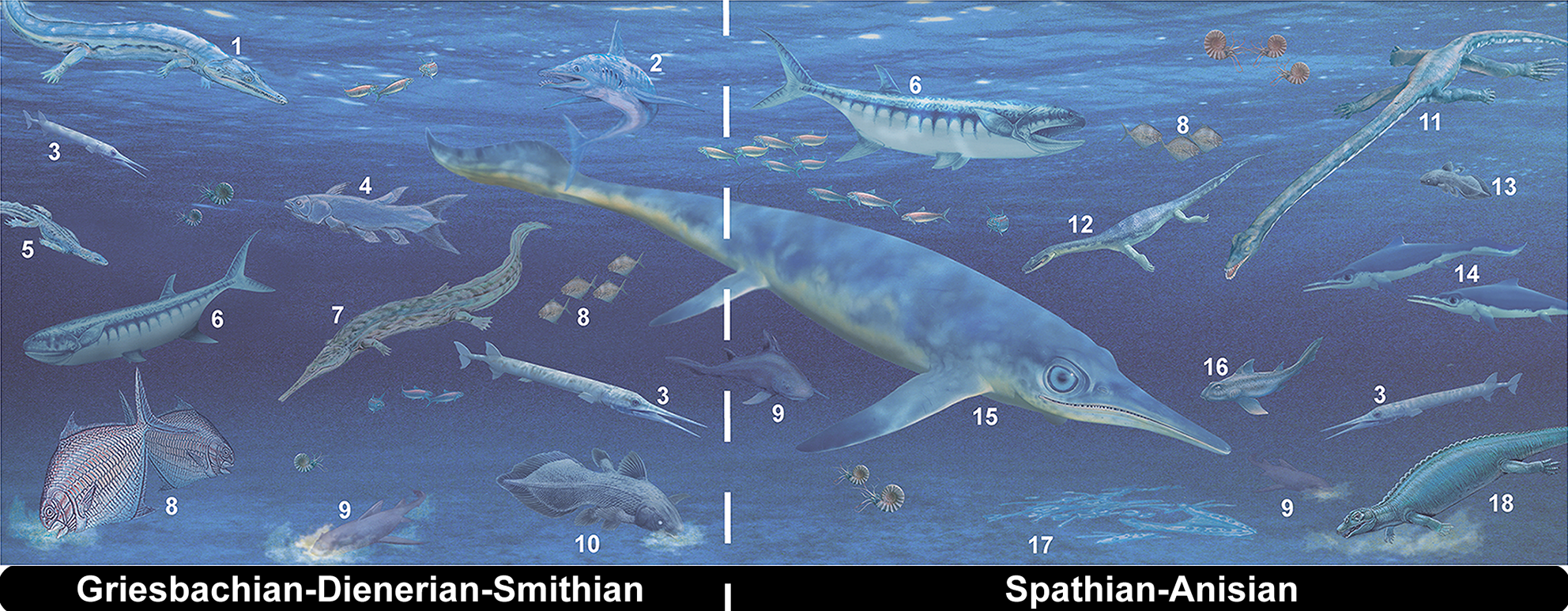Aphaneramma on:
[Wikipedia]
[Google]
[Amazon]
 ''Aphaneramma'' is an
''Aphaneramma'' is an
at
 ''Aphaneramma'' is an
''Aphaneramma'' is an extinct
Extinction is the termination of an organism by the death of its Endling, last member. A taxon may become Functional extinction, functionally extinct before the death of its last member if it loses the capacity to Reproduction, reproduce and ...
genus
Genus (; : genera ) is a taxonomic rank above species and below family (taxonomy), family as used in the biological classification of extant taxon, living and fossil organisms as well as Virus classification#ICTV classification, viruses. In bino ...
of marine temnospondyl
Temnospondyli (from Greek language, Greek τέμνειν, ''temnein'' 'to cut' and σπόνδυλος, ''spondylos'' 'vertebra') or temnospondyls is a diverse ancient order (biology), order of small to giant tetrapods—often considered Labyrinth ...
amphibian
Amphibians are ectothermic, anamniote, anamniotic, tetrapod, four-limbed vertebrate animals that constitute the class (biology), class Amphibia. In its broadest sense, it is a paraphyletic group encompassing all Tetrapod, tetrapods, but excl ...
. It lived during the Early Triassic
The Early Triassic is the first of three epochs of the Triassic Period of the geologic timescale. It spans the time between 251.9 Ma and Ma (million years ago). Rocks from this epoch are collectively known as the Lower Triassic Series, which ...
epoch
In chronology and periodization, an epoch or reference epoch is an instant in time chosen as the origin of a particular calendar era. The "epoch" serves as a reference point from which time is measured.
The moment of epoch is usually decided b ...
, approximately 252–247 Ma ago, and had a global distribution.
Fossils have been found in the Mianwali Formation of Pakistan
Pakistan, officially the Islamic Republic of Pakistan, is a country in South Asia. It is the List of countries and dependencies by population, fifth-most populous country, with a population of over 241.5 million, having the Islam by country# ...
, Madagascar
Madagascar, officially the Republic of Madagascar, is an island country that includes the island of Madagascar and numerous smaller peripheral islands. Lying off the southeastern coast of Africa, it is the world's List of islands by area, f ...
, the Zhitkov Formation of Russia,Zhitkov Formationat
Fossilworks
Fossilworks was a portal which provides query, download, and analysis tools to facilitate access to the Paleobiology Database, a large relational database assembled by hundreds of paleontologists from around the world.
History
Fossilworks was cr ...
.org and the Vikinghøgda Formation (Kongressfjellet Formation) of Svalbard
Svalbard ( , ), previously known as Spitsbergen or Spitzbergen, is a Norway, Norwegian archipelago that lies at the convergence of the Arctic Ocean with the Atlantic Ocean. North of continental Europe, mainland Europe, it lies about midway be ...
(Norway
Norway, officially the Kingdom of Norway, is a Nordic countries, Nordic country located on the Scandinavian Peninsula in Northern Europe. The remote Arctic island of Jan Mayen and the archipelago of Svalbard also form part of the Kingdom of ...
).
''Aphaneramma'' had a skull
The skull, or cranium, is typically a bony enclosure around the brain of a vertebrate. In some fish, and amphibians, the skull is of cartilage. The skull is at the head end of the vertebrate.
In the human, the skull comprises two prominent ...
about in length. Its jaws were very long, similar to the extant gharial
The gharial (''Gavialis gangeticus''), also known as gavial or fish-eating crocodile, is a crocodilian in the family (biology), family Gavialidae and among the longest of all living crocodilians. Mature females are long, and males . Adult males ...
's, and lined with small teeth
A tooth (: teeth) is a hard, calcified structure found in the jaws (or mouths) of many vertebrates and used to break down food. Some animals, particularly carnivores and omnivores, also use teeth to help with capturing or wounding prey, tear ...
. This adaptation suggests that it may have preyed on fish. A marine lifestyle for this animal was proposed.
''Aphaneramma'' is closely related to '' Cosgriffius'' from North America
North America is a continent in the Northern Hemisphere, Northern and Western Hemisphere, Western hemispheres. North America is bordered to the north by the Arctic Ocean, to the east by the Atlantic Ocean, to the southeast by South Ameri ...
.
References
{{Taxonbar, from=Q2544680 Lonchorhynchines Triassic temnospondyls of Europe Triassic amphibians of Europe Triassic temnospondyls of Asia Triassic amphibians of Asia Induan life Olenekian life Fossils of Norway Fossils of Russia Fossils of Pakistan Fossil taxa described in 1904